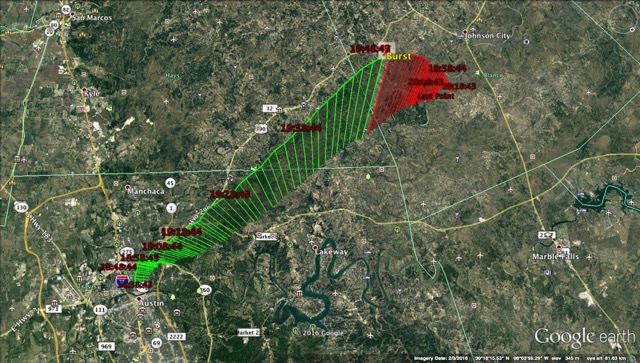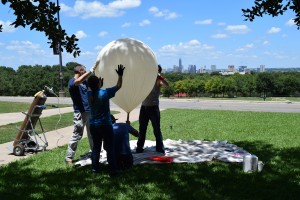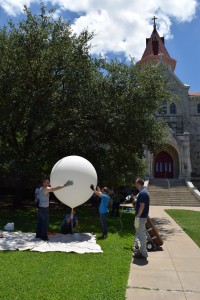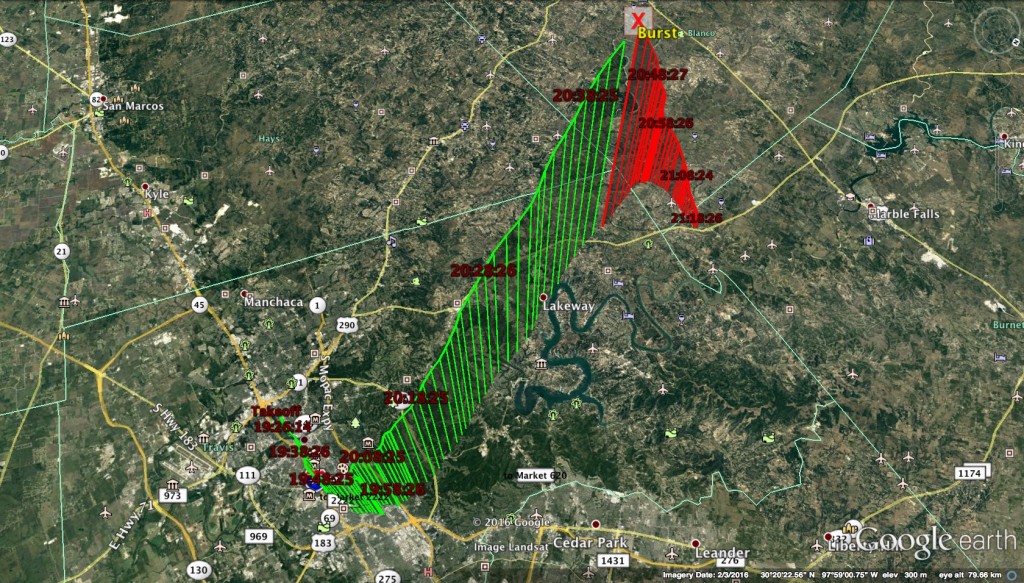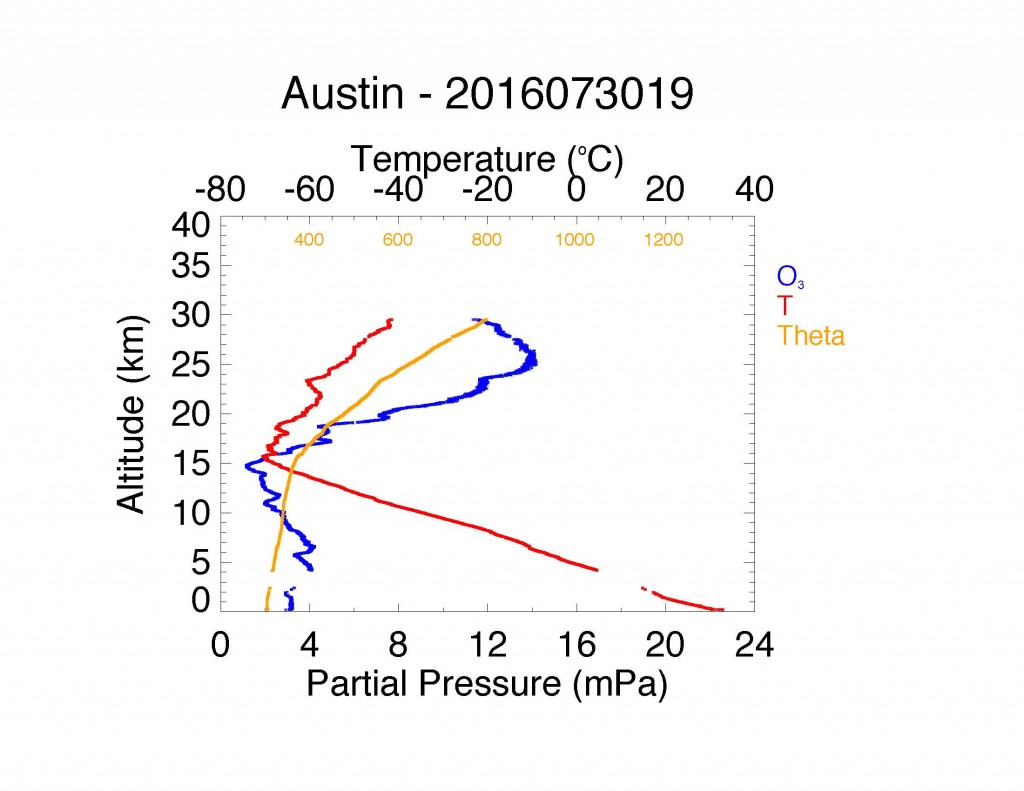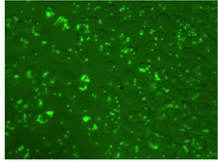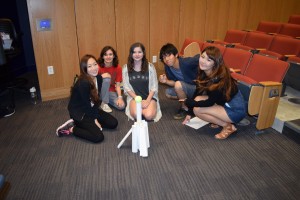Juniors and Seniors if interested please email Dr. Toledo to be placed on a mailing list with course updates.
Category Archives: School of Natural Science News
Welcome Our New NSCI Full-Time Faculty Members
I’m excited to welcome our new, full-time colleagues to NSCI:
- Kaitlyn Phillipson, Assistant Professor of Mathematics
- Raychelle Burks, Assistant Professor of Chemistry
- Thomas Moe, Visiting Assistant Professor of Computer Science
- Mitch Phillipson, Visiting Assistant Professor of Mathematics
- Erika Schwarz, Visiting Assistnat Professor of Biological Sciences
- Casey Parish-Fisher, Assistant Professor of Forensic Science
Be sure to say, “Hello!” and offer your welcome and greetings to our new, full-time colleagues this year.
Kaitlyn comes to us from Texas A&M, where she just earned her Ph.D. this past Spring. Her husband Mitch got his Ph.D. from A&M in May 2015 and spent the last year teaching at SUNY Oswego. They both join our Dept. of Mathematics.
Raychelle (a.k.a., Dr. Rubidium or @DrRubidium on Twitter) joins our Dept. of Chemistry from Doane College, where she taught the last 3 years after two years of teaching at Seattle University and a summer semester at Seattle Central Community College. Her Ph.D. is from U. Nebraska, Lincoln.
Thomas just retired after 23 years working with the Texas Legislature, most recently as a manger of infrastructure and operations in I.T. His MS degree is from the University of St. Thomas in St. Paul, MN. He’s joining our Dept. of Computer Sciences.
Erika arrives at St. Ed’s after adjuncting for 3 years at ACC (where she taught) Biotechnology and Biology) while she was completing her Ph.D. at the University of Texas, earning her degree this past May. She will be on the faculty in the Dept. of Biological Sciences this academic year.
Finally, we’re happy to formally welcome Casie Parish-Fisher as a member of the NSCI faculty! Casie has led the Forensic Science program at St. Edward’s in the School of Behavioral and Social Sciences since 2008. She had her Ph.D. conferred this past year from the University of Central Lancashire and moved her program to NSCI (under the Dept. of Chemistry) this past summer.
Welcome to all!
Austin Area STEM Teachers Attend Second Weather Balloon Launch
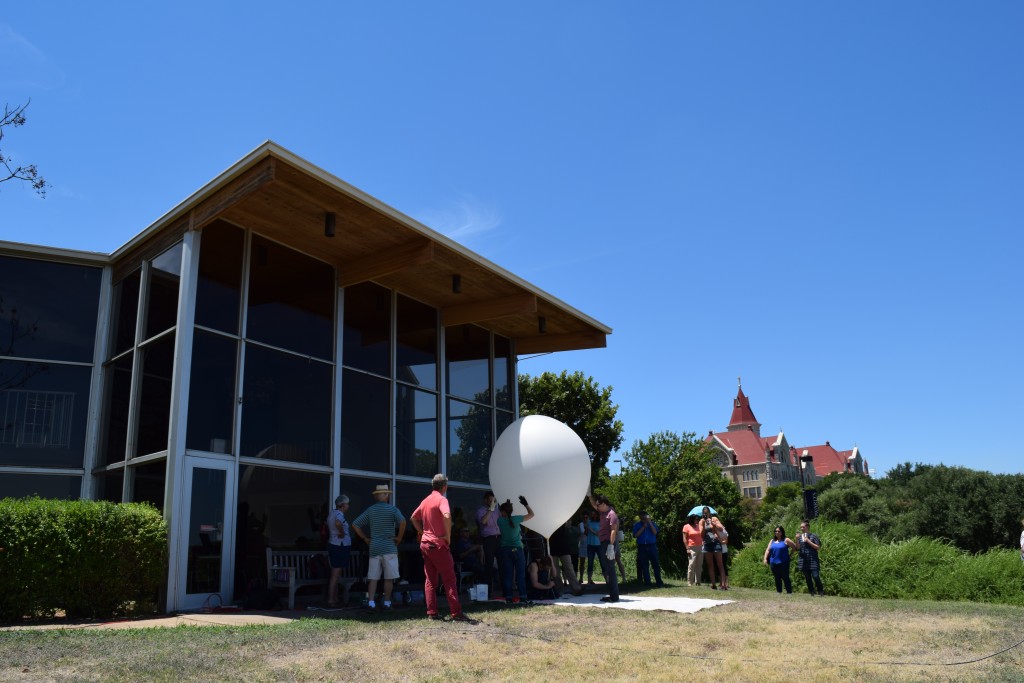
Weather balloon inflated with helium in front of the Mary Moody Northen Theatre at St. Edward’s University prior to its release around 1:30 pm CDT on Thurs., 4 Aug. 2016.
A dozen Austin area STEM middle and high schools teachers participated in the second weather balloon launch from St. Edward’s University on Thursday, 4 August.
The teachers were attending a workshop entitled, “Air Quality in Austin,” as part of the larger Austin Area STEM Teachers Conference, hosted at St. Edward’s University 2 – 5 August.
The air quality workshop is sponsored by a grant from 3M, while the data are provided courtesy the Tropospheric Ozone Pollution Project (TOPP), which has been funded by TCEQ, NASA, Fulbright, and the Shell Center for Sustainability at Rice University. Our current project at St. Edward’s University is funded by the Capital Area Council of Governments (CAPCOG).
Dr. Steven Fletcher (Assoc. Prof. of Education), Dr. Bill Quinn (Prof. of Biological Sciences), Dr. Paul Walter (Visiting Asst. Prof. of Physics), Ms. Ashley Moreno (undergraduate student), and Dr. Gary A. Morris (Dean of Natural Sciences and Prof. of Physics) led the workshop at St. Edward’s University.
As part of the workshop, attendees participated in a weather balloon launch around 1:30 pm in front of the Mary Moody Northen Theatre at St. Edward’s. Another glorious day made for good viewing as the balloon ascended on its journey through the ozone layer to an altitude of 28 km before bursting and descending back to Earth, landing somewhere near Northeast of Johnson City, Texas around 3:30 pm.
You can eventually find all of our project data on the St. Edward’s University Institutional Repository. A few plots from today’s flight are below.

Ozone (blue), temperature (red), and potential temperature (orange) data from the weather balloon flight of 4 August 2016.
First Weather Balloon Launch from the Hilltop!

Preparing to release the balloon in front of Main Building with Austin in the background on Saturday, 30 July 2016 – the first flight from St. Edward’s University.
The Tropospheric Ozone Pollution Project (TOPP) has come to the Hilltop! The project, started by Dean of Natural Sciences Gary A. Morris in Houston in 2004, has since coordinated >750 flights from Beaumont, College Station, Ft. Worth, Galveston, and Nacodoches in Texas; Valparaiso and Ft. Wayne in Indiana; University Park, PA; Cumberland, MD; St. Louis, MO, and Hastings, MI, as well as Las Tablas, Panama; San Jose, Costa Rica, and Sapporo, Japan.
Now we add Austin, Texas to the list. With funding from the Capital Area Council of Governments (CAPCOG) and the Texas Commission on Environmental Quality (TCEQ), the St. Edward’s University team will fly 16 weather balloons to measure ozone along with meteorological data over the next two ozone seasons (2016 and 2017).
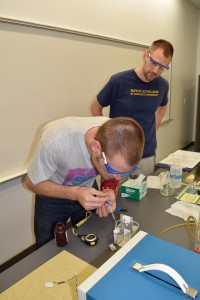
Ace Manning (SEU undergraduate) prepares an ozonesonde for flight while Physics Professor Paul Walter supervises.
The project’s initial Austin flight occurred on Saturday, 30 July. The launch team prepped and calibrated the instrument in the John Brooks Williams South Building, then assembled in front of historic Main Building to fill and release the balloon around 2:15 pm CDT. The balloon ascended past 30 km at a rate of ~ 5 m/s before popping. Members of the launch team were able to see the balloon (a small white dot) overhead for the entirety of the ascending portion of the flight.
The balloon came down near Spicewood, TX about 2 and a half hours later. The initial ozone profiles can be found on the project website.
The second weather balloon launch has been scheduled in conjunction with the Austin Area STEM Conference for Thursday, 4 August at around 1:30 pm CDT, weather permitting. Given the start of the construction project at Main Building, our next launch will occur on the North side of the Mary Moody Northen Theatre Building. All are welcome to come watch.
Portal to the World Arriving at St. Edward’s – Sept. 2016
What would you do if you had 10 minutes to communicate with someone from the other side of the world? Share a meal? Share a song? Perform a short play? Would you speak? What if you didn’t know the language? How do we communicate with others in cultures different from our own? What can we learn about each other and ourselves?
Starting 30 August 2016 and continuing throughout September, St. Edward’s University will host a portal (a technologically enhanced shipping trailer) from Shared Studios. The gold colored portal will be on our campus to provide our students, faculty, and staff as well as Austin area schools and our Austin community family members a chance to connect to a part of the world they might otherwise never experience in person.
Take on Your World in the Shared Studios Portal. Learn more about what others have done on Instagram for Shared Studios and on YouTube and see the significant media coverage of this groundbreaking project that we now have the chance to bring to our campus.
More details to come, including reserving times for your planned activities. Watch for future posts with more information.
How will you spend your time in the Portal? And where will you go?
This project is coming to St. Edward’s thanks to the efforts of the Office of Information Technology with support from faculty and staff in Instructional and Emerging Technology, the Global Engagement Office, the School of Humanities, and the School of Natural Sciences.
NEW INFO: Here’s a link to the sites with which the portal will be connected:
Lucian Symposium 2016 – Global Health and Infectious Disease: CANCER – NOVEL TARGETS AND THERAPIES
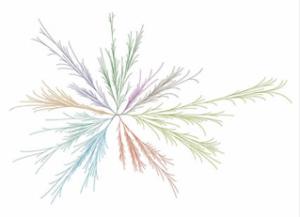
Displaying the relationship among target proteins by representing the Euclidean distance among gene signatures.
Despite billions of dollars, decades of research, and an unparalleled level of international cooperation between research scientists and clinicians, cancer remains a major cause of death worldwide.
Therapies have improved and many forms of cancer are now treatable, but the disease still kills over eight million people throughout the world each year. For this reason, cancer research funding represents one of the largest expenditures of the United States federal government, and has led to improved medical treatments as well as greater understanding of the molecular intricacies of the disease. However because cancer is now considered not simply one disease but rather a multitude of independent disorders that can all result in malignant cellular growth, the dream of a cure for cancer, the “magic bullet”, to miraculously eliminate the disease, is now considered unrealistic in light of these overwhelming complexities.

Activation of the C-Jun N-terminal kinase (JNK2) through conformational change from the DFG-out (yellow) to DFG-in (blue) state.
The interdisciplinary approach that has emerged is offering new hope for therapies and treatment. Since not all tumors are the same, molecular targeting, or the attempt to tailor therapy to the specific abnormalities causing disease, has become one of the most promising areas in cancer biology research. By combining molecular biology and biochemistry with combinatorial chemistry and organic chemistry , pharmaceutical research has embraced the field of rational drug design as a specific application of molecular targeting. In the past few years, the rapidly advancing field of cancer immunology has produced several new methods of treating cancer. These immunotherapies increase the strength of immune responses against tumors.
However, cancer cells are sometimes able to avoid detection and destruction by the immune system. Drug development takes time, and it is years, often decades, before a drug that shows promise in the lab will make it into the clinic. And of course resistance to chemotherapy and molecularly targeted therapies remains a major problem. This symposium seeks to highlight some of the innovative and creative approaches being pursued in light of these challenges.
EVENT SCHEDULE – Friday , September 23rd , JBWS Carter Auditorium
9.30 am Welcome
9.40 am Dr. Eamonn F. Healy (St. Edward’s University): “Modulating Kinase Activity Through Desolvation”
10.10 am Dr. Michael A. White (University of Texas Southwestern Medical Center): “Towards Patient-based Cancer Therapeutics”
11.00 am Break
11.15 am Dr. Beverly A. Teicher (National Cancer Institute): “Antibody conjugate therapeutics: challenges and potential”
12.05 pm Dr. Antonio Fojo (Columbia University Medical Center): “Novel Therapies for Cancer: Why Dirty Might Be Better ”
1.00 pm Lunch and Student poster session: Foyer, JBWN
TOPP Alumna Covers Go-For-Launch! at St. Edward’s University
Natalie Ferrari, one of nearly 100 alumni of the Tropospheric Ozone Pollution Project (TOPP), now works at KXAN as an on-air meteorologist. She came to St. Edward’s on Tuesday, 12 July, as part of Go-For-Launch! to both give a talk to the participants on her career trajectory as well as to do a story on the camp itself. You can see that story, which appeared on the 6 pm news on Wednesday, 13 July, here!
During her presentation, she talked about the importance of making connections, pursuing internships, and communicating with others. Her broadcast career got started with an unpaid internships at Fox affiliate KRIV in Houston during her senior year at the University of Houston (UH). She worked in Abilene and College Station before arriving in Austin last Fall.
It was the first time Dr. Gary A. Morris, Dean of Natural Sciences at St. Edward’s, and Natalie had met in person in more than 5 years. Natalie graduated with a degree in Environmental Science from UH in 2011. While she was there, she took a class in Advanced Atmospheric Data Analysis and Laboratory from Dr. Morris during a semester in which he was a visiting faculty member at UH. She joined the TOPP team and helped launch weather balloons instrumented to measure ozone as well as temperature, pressure, humidity, wind speed, and wind direction.
“It’s always nice to meet up with former students to see what they’re up to and where they’ve been along the way,” said Dr. Morris. “I’m very proud of Natalie — she’s made it in a very tough field! And it’s fun to think that her experience as an undergraduate with our balloon research project might have helped her on that path.”
You can see Natalie on KXAN on the weekend and morning reports. Thanks to Natalie and KXAN for covering our inaugural Go-For-Launch! event at St. Edward’s University.
Go-for-Launch Brings Japanese and American Student Teams Together
St. Edward’s University hosted its inaugural “Go-For-Launch!” event 11 – 13 July 2016. 30 students participated with 15 here as part of the summer program with Asia Pacific University and 15 from Austin-area high schools.
Astronaut Mike Foreman met with students all three days, answering questions about life in space and the technical challenges associated with conducting experiments on the International Space Station (ISS).
Students formed teams of 5, with no more than 3 international students on any given team. Monday started with competitions included building a paper tower, selecting a team name, and designing a team mission patch. By Wednesday, teams had designed an experiment for the International Space Station.
In addition to Astronaut Foreman, Mac McCall (a longtime NASA contractor with Boeing who worked 18 years on ISS projects), Associate Vice President of Global Initiatives Bill Clabby, Visiting Assistant Professor of Physics Paul Walter, Dr. Paul Colosky (Space Physiologist), Dean of Natural Sciences Gary A. Morris, and CEO and Founder of Higher Orbits Michelle Lucas did the judging.
The winning project, designed by a team called, “Ryusei 5,” sought to watch a phytoplankton species (Nannochloropsis) develop on the ISS to determine the impact of the low gravity environment.
We look forward to hosting Go-For-Launch! at St. Edward’s again next summer, 10 – 12 July 2017. Spread the word!
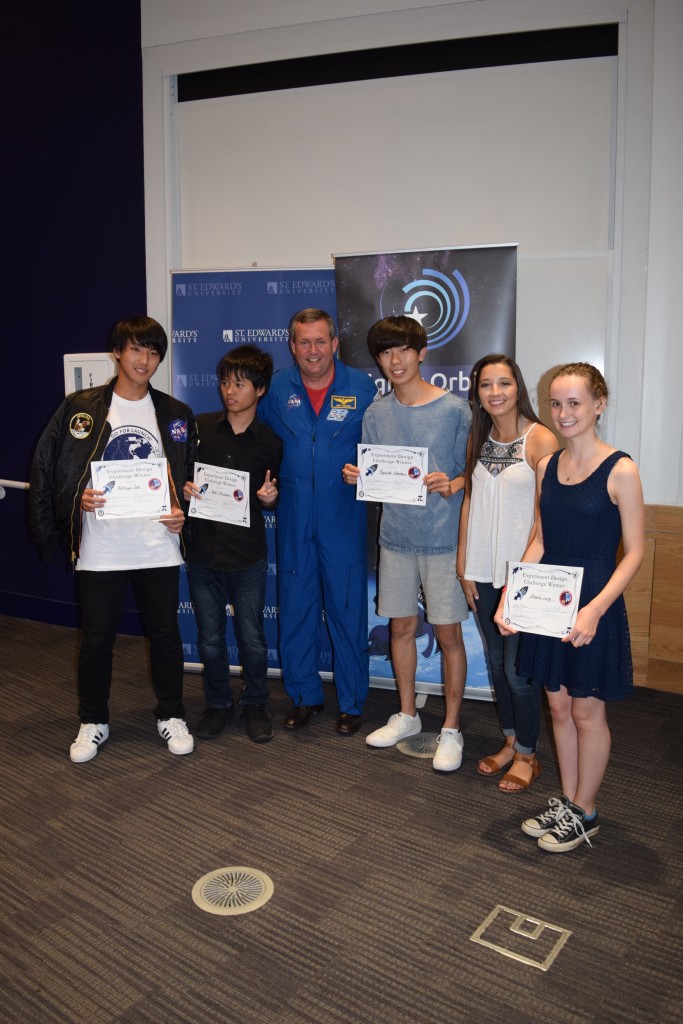
Winning team, Ryusei 5, with Astronaut Mike Foreman at the inaugural Go-For-Launch! event at St. Edward’s University, 11 – 13 July 2016.
4th of July 40% Discount for Go-For-Launch!
Spread the word — there’s a discount on registration for the Go-For-Launch event July 11 -13 at St. Edward’s University. Enter the code
STARS&STRIPES
and get 40% off the $250 registration fee. The discount is only good through July 4. Register here NOW!
For more info on the camp, follow these links:
http://goforlaunch.space <— general info
http://higherorbits.org/student-programs/go-for-launch/st-edwards-university-july-2016/ <— details on our program
Contact Gary A. Morris, Dean of Natural Sciences, with any further questions.
Summer Research 2016 Recap
With the completion of the 2016 Summer Research Symposium on June 27th, we have seen an increase in participation with over 70 undergraduate researchers that totaled over 11,000 hours of effort over the past 6 weeks. Generous funding for this research came from several different sources, including the Br. Romard/JD Lewis Student Research Fund, Community for Achievement in Research, Academics and Science (CASAR), Welch Foundation Chemistry Grant, Improving Undergraduate STEM Education (IUSE) Program, Dean’s Discretionary Fund, USDA and McKemie Summer Scholarship.
Thank you to all students as well as the 24 research supervisors who helped mentor and guide this research over the past few months. We’d also like to thank the Office of Sponsored Programs and the School of Natural Sciences for helping make these research projects and symposium possible at SEU.
For those of you who participated in summer research this year, please take a minute to take both the SEU and national post-research surveys that will give us valuable information for the future development of our research programs at SEU:
National survey: SURE III Survey
SEU survey: https://stedwards.co1.qualtrics.com/jfe/form/SV_8GPgfC6kwcML1uB



